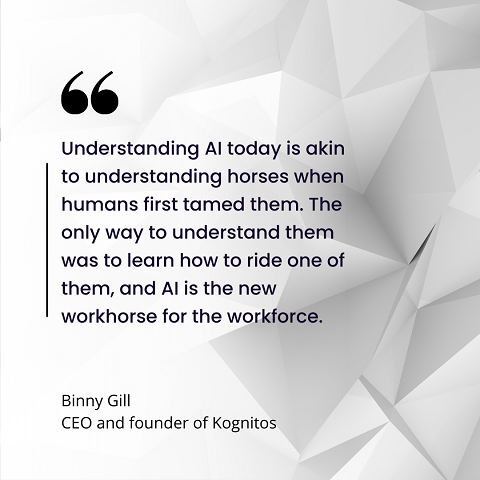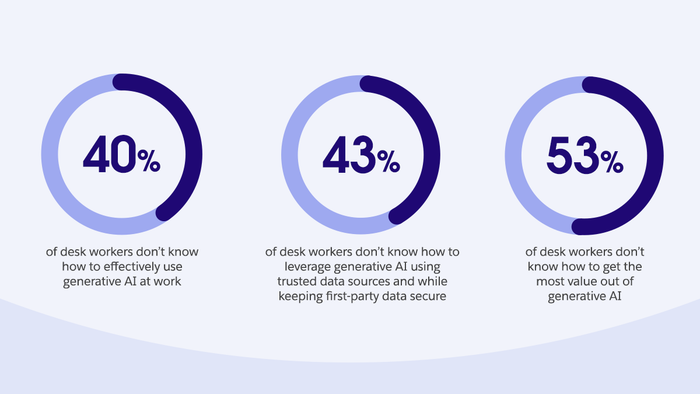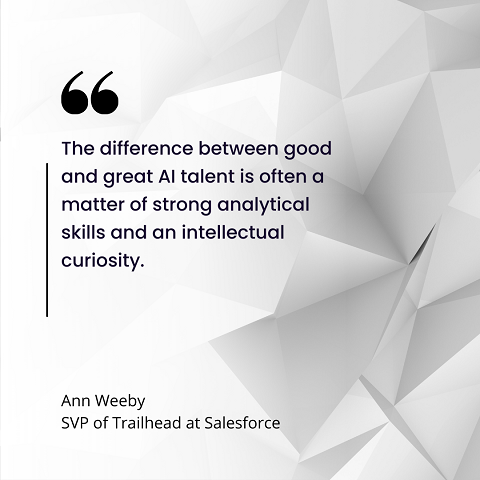AI Training in the Workplace: Navigating Challenges, Embracing OpportunitiesAI Training in the Workplace: Navigating Challenges, Embracing Opportunities
There's an urgent need to close the generative AI skills gap in organizations. Here are tips on how to upskill employees to take better advantage of GenAI.
November 20, 2023

AI is quickly evolving, creating an urgent need for upskilling across industries and sectors.
However, workers' digital skills have failed to keep up over the years because many industries continue to rely on a traditional educational model.
Companies must foster a culture where employees strive to learn and grow and provide them with opportunities to continuously learn the latest tools and valued skills. Bite-sized, continuous learning is essential.
More broadly, upskilling opportunities can lead to a more engaged workforce, which can boost productivity.
Research shows that two-thirds of employers are looking for ways to integrate generative AI across their workforce. However, most employees say they lack the skills to use generative AI safely and effectively, signaling a pervasive skills gap.

Gill-Kognitos
The solution is for companies to invest in their people — helping employees skill up so they can thrive in this new landscape and advance their careers.
Training Teams for AI Success
Companies have struggled to get ahead of their employees using the various platforms across multiple business units, according to Pete Erickson, CEO of Modev.
"I know several companies have completely banned ChatGPT and others like Bard from being used while at work," he said. "This is a defensive maneuver to keep company IP from being consumed in the models and available to pretty much anyone that leverages them."
From his perspective, the first part of the educational process for companies has been to get the message out that large language models (LLMs) are not great when it comes to protecting data.
"However, the second part of this process is having companies figure out policies that help them stay ahead of the generative AI curve and allow their employees to leverage the tools for productivity," he added. "There's a strong ROI component to this."
The key challenge for organizations is determining how they can best leverage LLM technologies, either through APIs or building their own foundational model, and then how to deploy and manage them, Erickson said.
Ann Weeby, senior vice president of Trailhead at Salesforce, explained that employers have a responsibility to ensure workers have the skills they need to succeed in the current and future workforce.
When it comes to generative AI, 67% of workers expect their company to help them learn how to use the technology, but two-thirds say that isn't happening today, she said.
"Generative AI presents massive opportunities for businesses and workers alike but, to close the current skills gap, it's up to business leaders to democratize access to needed skills and training," Weeby said.
That means employees need to equip themselves with the right skills to thrive in an AI-intensive world.

AI-skills_0
Figure 1: Workers lack the know-how to take advantage of generative AI. (source: Salesforce)"Understanding the fundamental applications of AI, such as the automation of digital tasks, is essential," she said. "But it's not just about technical expertise — the difference between good and great AI talent is often a matter of strong analytical skills and an intellectual curiosity."
Weeby noted that workers who can harness the power of generative AI can get more done faster and spend extra time on rewarding, meaningful work.
"They'll be at a major advantage when it comes to serving customers, driving innovation, and making their companies stronger," she said.

horse-taming
Encouraging Experience with AI
The most important skill is experience with AI, claimed Binny Gill, CEO and founder of Kognitos.
"Understanding AI today is akin to understanding horses when humans first tamed them," he explained. "The only way to understand them was to learn how to ride one of them, and AI is the new workhorse for the workforce."
He suggested that everyone should spend a portion of each day trying to use AI to do something useful for themselves.
"Unfortunately, many organizations have banned the use of ChatGPT, citing privacy and ethical concerns, which will keep the workforce uneducated for a longer time while their competitors will figure out how to ride this new workhorse and get ahead," he added.
From Gill's perspective, the best way to encourage the use of generative AI is through sharing examples of successful usage.
"Furthermore, the organizations should allow experimentation time for their employees, as using the technology is a skill that will pay dividends in the future," he said. "Knowing AI intimately also reduces a lot of the concerns people have with AI."
Crafting an AI Education Strategy
Erickson believes a combination of in-person and virtual training is key.
"There's still nothing quite like the in-person educational experience, but we know this does not scale as well," he said. "Self-paced asynchronous learning is a great tool to ensure there's widespread education and adoption of new technologies and methodologies."
He added that AI has a great opportunity to make education a very fun process and suggested incorporating generative AI tools into the curriculum and make it compelling and fun for staff.
"I've seen some really cool internal hackathon-type events popping up at organizations to help staff understand prompt engineering, generative AI, and LLMs," he said. "There are so many fun ways to drive innovative learning across the org chart."
Gill said he's found it effective to encourage managers to "show off" their work using generative AI and explain how it helped them become faster.
"They should also explain all the struggles they had in using the AI technology to prepare employees for a few initial failures," he said.

Weeby
Asking members of the workforce regularly in public forums about how they used AI to accelerate themselves is an effective way to remind people not only about the power of AI but also that they are expected to be more productive once AI tools become available to them.
"In larger organizations, it might be useful to set Slack or Microsoft Teams channels for employees to discuss how they are using AI to enhance or accelerate their work," Gill said.
Weeby said organizations can start crafting an AI education strategy by clearly defining business objectives and goals that AI can potentially support.
Above all, it's important to invite open dialogue and come together to drive positive change with the power of AI, she added.
"We are in the early days of this transformative technology," Weeby said. "It's necessary to embed guardrails and guidance across any organization."
Fostering Innovation — and Failure
Aligning the use of AI with business objectives becomes easy if the mission for the workforce is to use AI to accelerate what they already do, Gill said.
"To foster innovation, organizations should encourage AI as an automation solution that reduces mundane tasks and frees up time for the employees to focus on higher level innovation projects," he said.
C-level leadership in the company should reiterate periodically about the urgency of using and understanding AI in the organization from an efficiency perspective, he added.
At the same time, the company should educate the workforce on the pitfalls and dangers of using AI blindly without review. "There are deep bias and hallucination problems in AI today, and picking AI automation tools that remove the hallucination and biases from the usage of AI is a critical consideration," Gill advised.
Erickson added that teams must be able to fail, noting that while AI is certainly a technology that opens amazing opportunities, it also has many pitfalls.
"We've seen many examples of AI gone wrong, and I really hope the people who led those initiatives did not suffer as a result," he said. "It's a new era with new possibilities which favor those who are willing to experiment and fall down in the process. This approach requires leaders who encourage innovation and failure."
About the Author
You May Also Like








.jpg?width=700&auto=webp&quality=80&disable=upscale)
